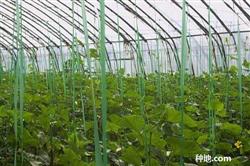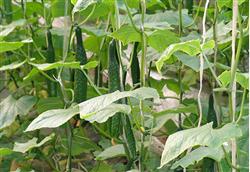How do cucumbers grow without soil?

How to carry out soilless cultivation of cucumber? Please introduce that soilless cultivation can avoid diseases and insect pests and continuous cropping obstacles caused by soil infection. compared with soil cultivation, soilless cultivation has the characteristics of reducing pesticide dosage, improving crop yield and quality, saving fertilizer, labor and water, and is not restricted by land fertility. In this paper, cucumber was planted by soilless cultivation in purple cap evergreen experimental garden, and its cultivation techniques and characters were explored. 1. Soilless cultivation techniques of cucumber. 1. Supporting facilities and ⑴ supporting facilities of cultivation system. ① greenhouse plastic greenhouse (specification is 35m × 4m x 6m), the area is 210m2, note that medium, small shed, water arch shed and other facilities are not recommended, for protection facilities, the height is required to be appropriately high, so that the environment has a certain ability of regulation and control. ② adequate water source, using tap water automatic water supply, fertilizer supply system. ⑵ cultivation system. ① cultivation trough: the bag cultivation method is adopted. Generally, each bag is 25ml 30cm in diameter and 40ml 45cm in height. Each shed can hold about 600 bags. ② irrigation system. One drip irrigation belt is laid in each trough, and plastic pipes can be used in other water supply and fertilizer management channels, and an automatic water supply and fertilizer control system is adopted. ⑶ culture medium. The mixed matrix is mainly composed of sawdust or peat: slag = 4:6, peat: perlite = 1:1. The fertilizer ratio is ammonium sulfate: ammonium dihydrogen phosphate: potassium sulfate = 10:7:7, but it should be noted that this ratio should be flexibly applied according to the differences in the use of fertilizers in different places, and should not be applied mechanically in order to get the best effect. ⑷ variety selection. Cucumber, "Zhongnong No. 5" cucumber. 2. Cultivation and management technology of greenhouse ⑴ arrangement of cucumber stubble in greenhouse. There are generally three ways of cultivation in early spring, winter and long-term cultivation. Long-term cultivation is adopted here. Seedlings were raised by ⑵. Due to the superior temperature and light climate in our city, raising seedlings in greenhouse is generally not limited by time. The way of raising seedlings is to raise seedlings with a hole tray, first pour the substrate into water, then broadcast the seeds after sprouting, cover with a layer of borate and water, and then cover with a film to keep warm and moisturize. It keeps 25 ℃ 30 ℃ during the day and 15 ℃ at night. The air and substrate temperature with higher water content is beneficial to the formation of female flowers, so the water fertilizer should not be over-controlled, but should be kept moist during the irrigation period. Generally speaking, it is better to control the sunshine at 8 Mui for 10 hours. Attention should be paid to strengthening nitrogen, nutrition and supply. 0.1% urea can be foliar sprayed with 1 Mel twice to promote female flower differentiation, carbon dioxide fertilization can also be applied, or ethylene can promote female flower differentiation and increase the number of female flowers. When more than 50% of the seedlings arch the soil, remove the film in time and enter the seedling stage management. the whole seedling stage is about 25 ml for 30 days. ⑶ was transplanted and planted. Generally, cucumber seedlings can be transplanted and planted with 3 mi 4 leaves. Planting for each cultivation bag one by one, divided into six rows, each shed can be planted in about 600 cultivation bags. After planting, one drop of planting water should be used for about 5 days, and the normal production management stage should be carried out after the seedlings are slowed down. ⑷ field management. ① environment control and regulation. Due to the sufficient temperature and light conditions in our city and the small temperature difference between day and night, it is relatively easy to master the environmental regulation and control. Generally, in spring and autumn, there is no need for much manual adjustment, and the greenhouse can be covered with an anti-insect net, but in the severe winter, if the temperature is lower than 25 ℃ and 15 ℃ at night, you can change the plastic film cover, or cover straw felt, when it is hot in summer, cover the shade net, or use spray cooling and other measures to control the temperature below 30 ℃ as far as possible and the temperature difference between day and night above 10 ℃. ② water and fertilizer management. When using the drip irrigation system, the cucumber that had just planted slow seedlings was irrigated with 400ml per plant per day, and the amount increased gradually as the plant grew. Due to the exuberant growth and large amount of cucumbers in the full melon stage, each plant needs to be irrigated with 2000Mel 2500ml per day, and the maximum irrigated total concentration is 1.20Mel 1.50 times. After the weather turns hot, the peak melon period has passed, then the concentration should be gradually reduced to half of the amount, but the amount of pouring can not be reduced. The suitable pH value of nutrient solution is 5.60 / kg / 6.20. ⑸ plant adjustment. Cucumber seedlings slow down very quickly after planting, so it is necessary to prepare hanging vine materials, generally choose nylon wire as hanging wire, use iron wire to make double hooks that can be wound around the hanging rope on the thick iron pipe in the upper part of the greenhouse, one end of the nylon line is wound on the rope rack, and the other end is lightly wound around the base of the plant. When the plant grows to a certain height (about 2 meters), the superfluous rope can be put down gradually, or the seedling at the base can be coiled on the steel frame near the ground. For the main vine melon-based varieties, the lateral vines and tendrils below 10 nodes can be removed in time during planting. The vines should be carried out on a sunny day to avoid breaking the main vines. When the main vine grows to the top of the thick iron tube, you should pick the heart to promote the growth of melon and side vines. ⑹ harvesting. It is usually harvested once every 3 days in 2MUR. It is harvested every other day or even every day when it enters the full fruit period. Melon harvesting should be carried out in the afternoon, when the melon strips are fresh and tender, the water is sufficient, and the quality is good. Second, the character performance and economic benefit analysis of cucumber after soilless cultivation, the main characters of cucumber are as follows: 1. The shape of cucumber is straight and large, and the color is beautiful. Generally speaking, each piece weighs 1.50 kilograms on average. 2. Rich nutrition, good quality and good sense of taste. The contents of vitamin C soluble solids and sugar increased to a great extent. 3. No pollution, can reach the standard of green food. Soilless cultivation has better solved the problem of serious pollution caused by the extensive use of chemical fertilizers and pesticides, and the excessive content of substances harmful to human health in the melon body, which is both nutritious and safe. Through the preliminary calculation of the provincial green food center, the cucumber produced by soilless cultivation in purple cap evergreen garden can meet the A-grade green food standard. 4. The yield increased greatly, and the ratio of cucumber yield per mu to conventional yield was about 5:1. It can reach about 100000 kilograms per mu every year. Click to get more cucumber planting techniques click to get more vegetable planting techniques
- Prev

Is there any way to increase the yield of cucumber?
Is there any way to increase cucumber production? Please instruct that cucumber is a kind of normal temperature crop. Generally speaking, cucumber grows best at 20 ℃ and 30 min. It likes dampness and is afraid of drought. Under suitable climatic conditions, how to increase cucumber production? There are the following methods for reference. The method of smoking and increasing female. When the cucumber seedlings have 2-4 true leaves.
- Next

What caused the cucumber to die?
What caused the cucumber to die? Please introduce the main causes of dead cucumber trees are as follows: first, excessive watering at one time leads to the decrease of ground temperature and the production of retting roots caused by insufficient oxygen demand of roots is the main cause of dead cucumber trees. Secondly, excessive use of chemical fertilizer caused soil salinization, resulting in cucumber root burning.
Related
- Where is it suitable to grow horseradish in China? it is expected to see the middle altitude horseradish in Alishan.
- How to prevent tomato virus disease reasonably? (Control methods included)
- Many people like to plant towel gourd on the balcony. What are the main points of this method and management?
- What crops can chili peppers be mixed with?
- Fertilization techniques and matters needing attention in Tomato
- What are the grafting techniques for peach seedlings in spring?
- Harm and control methods of root swelling disease of Chinese cabbage
- What are the pests of sweet potatoes? How to prevent and cure it?
- Symptoms, causes and Control methods of navel Rot in Tomato
- The cause of "Cucumber rotten bibcock" in Farmers' planting Cucumber and its Control Plan

